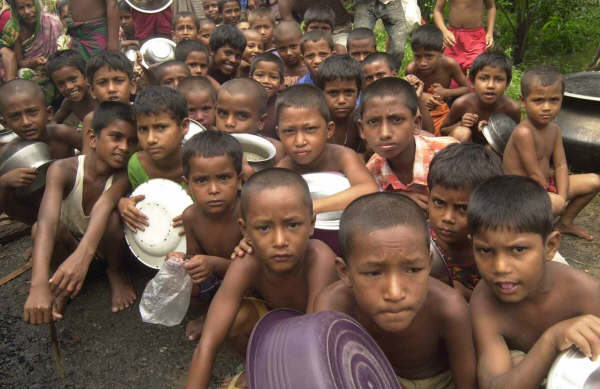The government of Bangladesh is stepping up its efforts to address monga, the seasonal food shortage that affects millions, particularly in the flood, drought and erosion-prone north.
The extreme poor, mainly farm labourers, face unemployment from September through November after planting the Aman crop, which accounts for almost 60 percent of the annual rice yield.
A second round of unemployment occurs in March and April after the Boro crop, accounting for another 30 percent, is planted.
The Public Food Distribution System (PFDS) is the government's main mechanism for addressing shortfalls in household food.
Nearly two-thirds of the total food distribution is done through seven main channels of the PFDS - Open Market Sales, Vulnerable Group Development, Vulnerable Group Feeding, Food for Work, Test Relief, Gratuitous Relief and Food Assistance for the Chittagong Hill Tracts Region.
Approximately 6.1 million households or 30.5 million individuals (based on an average household size of five) received assistance from these programmes in the year to June 2008, according to the World Food Programme (WFP).
 Photo: David Swanson/IRIN  |
| The first phase of the government scheme will provide employment for two million heads of hardcore poor families for 75 days |
100-day employment programme
But in addition, on 15 September the government launched a "100-day employment creation programme" to assist the hardcore poor.
The first phase of the US$295 million scheme provides employment for two million heads of families for 75 days to end-November.
The second phase is scheduled to start in March 2009 and will provide jobs to the hardcore poor for 25 days.
As part of the programme, beneficiaries are provided with employment involving activities such as building roads and embankments, cleaning and digging ponds, tree plantation, making fertilizer and flood repairs of public buildings.
Under the scheme each worker is being paid $1.50 a day.
Controversy
"Instead of pursuing a single approach the government should adopt a policy-mix strategy to address the problem," former economic adviser to the government and chairman of Palli Karma Shahayak Foundation (PKSF), Wahiduddin Mahmud, told IRIN.
While appreciative of government efforts, he expressed concern over the programme's sustainability and implementation.
Mahmud said monga could be addressed with locally available resources – and without foreign aid.
"People in monga-affected regions should not be encouraged to live on handouts. The government, the donor community, NGOs and all other concerned organisations should invest in the monga area to generate employment so that the people can work to earn their livelihoods," added Abul Barakat, general-secretary of the Bangladesh Economic Association.
New rice variety
In still another effort to alleviate monga in the northern region, the Rangpur-Dinajpur Rural Service (RDRS), a local NGO, is working to produce hybrid rice in the shortest possible time from paddy ratoons, allowing farmers to produce two yields from one batch of seeds.
Ratoons are shoots that grow up from the bases of crop plants after previous growths have been harvested.
RDRS planted paddy ratoons in late June and harvested the crop in September.
 Photo: David Swanson/IRIN  |
| Thousands face a lack of jobs from September to November following the planting of the country's Aman crop |
The Bangladesh Rice Research Institute (BRRI) has named the newly developed hybrid rice "BRRI-33" and is cultivating it on 40,000 hectares of land in five northern districts.
"BRRI-33 would be ready for harvest in mid-October, which would ensure jobs for agricultural labourers right at a time when jobs are not there," MA Majid, chief of the BRRI regional station at Rangpur, told IRIN.
"This will create employment opportunities for 2.75 million farm labourers and help 850,000 farmers in the monga-afflicted districts through increased production and new jobs," Majid said.
Majid, who also heads the "BRRI-33" and "monga mitigation" programme of the government, said after harvesting the new variety, farmers could go for early cultivation of non-cereal rabi crops such as potatoes, oil seeds, beans, okra and other vegetables, which would also create local employment during the dry season.
sa/ds/mw
This article was produced by IRIN News while it was part of the United Nations Office for the Coordination of Humanitarian Affairs. Please send queries on copyright or liability to the UN. For more information: https://shop.un.org/rights-permissions





